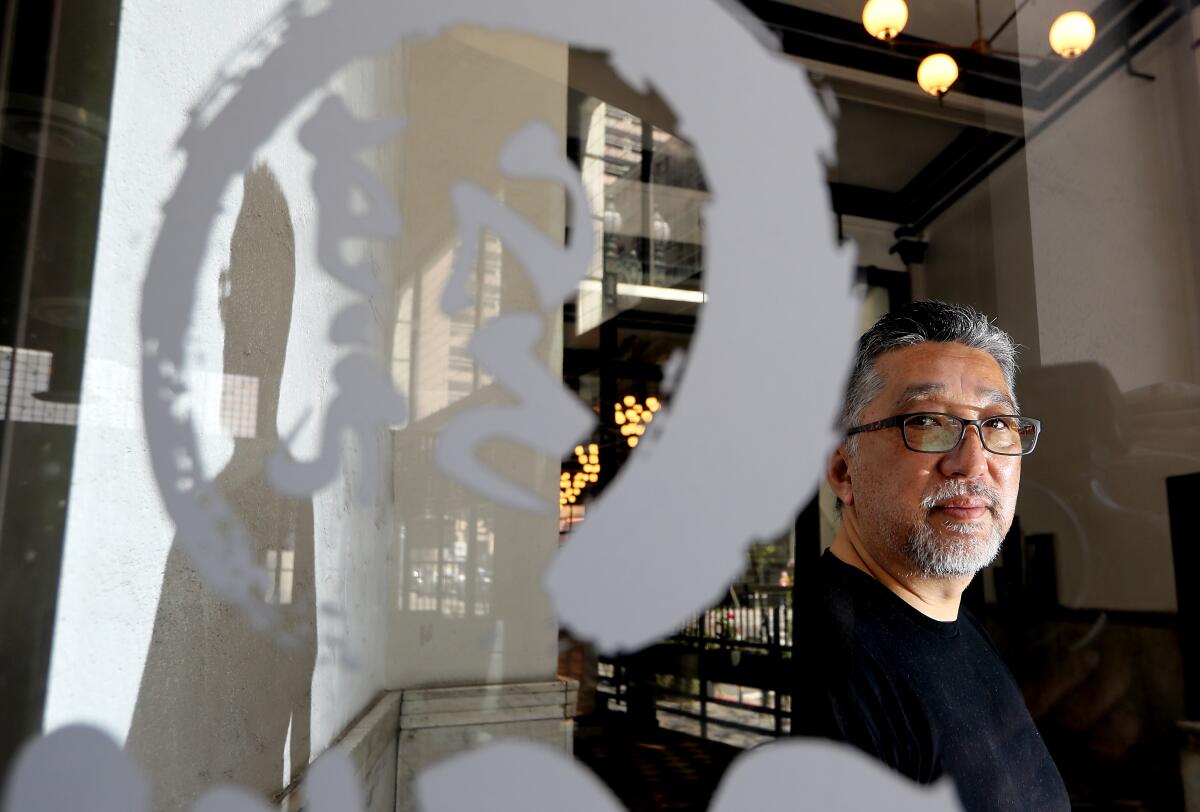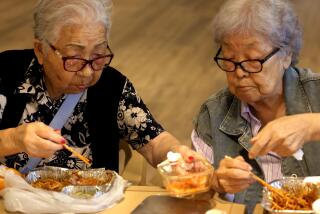Historic Suehiro Cafe is being evicted. Is rail development harming ethnic communities?

After 51 years in Little Tokyo, Suehiro Cafe is facing eviction, the latest in a string of legacy businesses forced out of the historic Japanese neighborhood.
Landlord Anthony Sperl filed the eviction notice last month. He’s hoping the area will grow to resemble Melrose Avenue, according to Suehiro Cafe’s owner, Kenji Suzuki.
Dennis Block, Sperl’s attorney, said Suehiro is being evicted for nonpayment of rent. But Suehiro’s attorney, Clifford Jung, said Suehiro has consistently tried to pay rent, but over the last year, the checks that it has sent by mail have not been cashed.
In-state business license records show Sperl as a partner in a limited liability corporation called Tokyo Greens registered in 2018, and he’s been seen gathering support at community meetings for a cannabis business in the area.
Suzuki plans to move the restaurant to a Main Street location a few blocks away and hopes to open the new space by June if all goes well. But heritage businesses in ethnic neighborhoods facing the same quandary around Los Angeles are not all so lucky.
Metro stations in Chinatown, Inglewood and Koreatown have contributed to a rapid escalation in property values. Longtime businesses, many of whose owners supported rail construction, now face steep rent hikes and evictions. Chinatown’s swap meets, once home to a majority of the area’s small business owners, are facing redevelopment.
In Inglewood, longtime businesses struggle to survive the decline in foot traffic brought about by construction. City programs meant to encourage dense development near trains have sparked a building boom around Koreatown’s subway stations, driving up residential rents.
Rail and mass transit in general are essential to any city’s future, and tough decisions about mass transit are essential to the future of downtown Los Angeles. But I’m disturbed by the similarities between this modern wave of transit development and the destructive development of the California freeway system in the 1940s.
Back then, boosters justified the wholesale destruction of Black, Latino and Asian communities in the name of “progress.” Now progress demands that we build rail, and again, it’s communities in Chinatown, South Los Angeles, Koreatown, Little Tokyo and Boyle Heights that are suffering.
It wasn’t supposed to be this way, said Gwen Muranaka, editor in chief of the Japanese American newspaper the Rafu Shimpo. Many Little Tokyo business owners believed rail construction would help them and supported the development. Now some of those businesses are not around to enjoy the benefits.
“The word from Metro has always been the regional connector, when completed, will be the second-most frequently traveled after Union Station, and that foot traffic would increase,” Muranaka said. “But I don’t think anyone anticipated all of these changes.”
It’s not clear when Metro’s regional connector will open. Planners have stated in the past that the new route would open in early 2023, and Metro in April began test runs of the 1.9-mile light rail tunnel connecting the 7th Street/Metro Center stop to Union Station. But it is becoming clear that rail development’s biggest benefits so far are for property owners, not historic communities and small businesses that rent their spaces.
Known for its extensive menu and late hours, Suehiro Cafe opened in 1972 as an American diner that later incorporated Japanese comfort food, much like neighborhood institutions such as Kouraku and Mitsuru Cafe. But what made Suehiro unique was that it was run by two women at a time when female entrepreneurship was rare, Suzuki said.
His mother, Junko Suzuki, and her younger sister, Yuriko Morita Regaert, knew little about running a business. When they started the restaurant, they were primarily hoping they could host mah-jongg nights there. But they cultivated strong relationships with their suppliers, customers and employees. “Okyakusama wa kamisama desu,” Junko would often say. The customer is God.
The sisters often subsisted on spoiled produce so they could have money to pay their staff. They added their customers’ favorites to the menu and encouraged staff members to add their own dishes, such as oroshi soba — buckwheat noodles topped with dashi, grated daikon, green onions and seaweed. They made friends who helped them handle the restaurant’s finances and eventually found enough regulars to create a sustaining business.
When Suzuki took over in 1991, the restaurant was more of a community project than the work of any one chef or individual, he said.
“It breaks my heart to know we’re not going to be there,” said Suzuki. “But we’re coming back as soon as we can.”
For the record:
1:56 p.m. May 5, 2023A previous version of this story said Kristin Fukushima is the managing director of the Little Tokyo Service Center. It is the Little Tokyo Community Council.
Kristin Fukushima, managing director of the Little Tokyo Community Council, said it’s too early to tell whether rail development will be good for the community. But there’s some reason to hope.
“It’s almost a decade of construction and lost business, and all the property flipping that happened during that time and the pandemic has created a lot of gentrification pressure,” she said.
But Little Tokyo has a few advantages. Japanese culture enjoys perennial popularity on social media, and viral trends can flood stores with customers and create new demand for products that have sat on shelves for decades. At Ginza Gifts, for example, a viral TikTok trend using the music of singer Tatsuro Yamashita has suddently increased demand for the ’80s and ’90s albums the store has stocked for decades.
The recent mainstreaming of anime and Japanese pop culture has also created more demand for Little Tokyo gift shops, and the annual Anime Expo at the Los Angeles Convention Center floods the neighborhood with customers for a week each year.
And this year, the Little Tokyo Community Council and a coalition of neighborhood groups will break ground on a 1st Street development that will add 220 units of affordable and permanent supportive housing to the area, and offer multiple ground-floor commercial spaces reserved for legacy businesses and other community activities.
The project represents the community’s attempt to take control of their own future, Fukushima said.
Rail development “will bring more people to Little Tokyo, but there are so many unanswered questions about how that will be managed and who will benefit,” she said.
More to Read
Sign up for Essential California
The most important California stories and recommendations in your inbox every morning.
You may occasionally receive promotional content from the Los Angeles Times.










